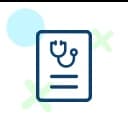Blood
Unlock special
discount on
this package
Login to Unlock 🔓
test Instructions
Booking Benefits Unlocked Worth FREE 799

Report Consultation

Diet Plan
*Available once your report is generated.
At Redcliffe Labs, we have a single goal: to give India its right to quality diagnostics.
Customers served
Tests Processed Everyday
Cities
Collection Centres
World Class In-house Labs
Home Collection Experts
1 Test Parameters
Triglycerides
1 PARAMETER INCLUDED
1 PARAMETER INCLUDED
- Triglycerides, Serum
Top Booked Health Checkup Packages
Parameters 94
Parameters 96
Parameters 90
Parameters 96
Parameters 100
Helps you know your test better
What is the Triglycerides Test?
What increases your risks for high Triglycerides levels?
Are any risks associated with this test?
Are any special preparations required for the test?
Verified by Medical Expert

Written By
Sheena Mehta

Verified By
Dr. Pradeep Lodha

Table of Content
Introduction to Triglycerides Test
Triglycerides are the form of fat found in your blood. They are the main way your body stores extra calories from food. When you need energy, your body breaks down triglycerides and releases them into your blood. The Triglycerides test is a simple blood test that measures the amount of triglycerides in your blood. It is part of the lipid panel, which measures cholesterol levels. However, high levels of triglycerides can increase your risk of heart disease, stroke, and pancreatitis. The American Heart Association recommends that all adults aged 20 and older have their cholesterol and triglyceride levels checked every five years. Also, you may need to get tested if you have risk factors for heart disease, such as high blood pressure, diabetes, or a family history of heart-related diseases. You can choose Redcliffe Labs as your diagnostic health partner for the triglycerides test. You can book our appointment just a minute from the Redcliffe Labs app. With us, you do not need to go anywhere; the phlebotomist will come to your home to collect the sample. Book your triglycerides blood test today!
Test details in brief
| Also Known As | TG, TRIG, Triglycerides Test |
| Purpose | Besides measuring triglycerides, the test determines the risk of developing heart disease. |
| Preparation | Do not take any over-the-counter medicine without confirming with your doctor. |
| Fasting | 10-12 hours Fasting Required |
| Get Reports Within | Within 12 hours |
| Cost | INR 299 |

Purpose of the Triglycerides Test
The test is a part of the Lipid panel and helps to identify the risk of heart-related diseases. The triglycerides test serves several important purposes:
- Assessing Heart Disease Risk- Triglycerides are a major contributor to the development of atherosclerosis, the hardening and narrowing of arteries. High levels of triglycerides may increase your risk of heart attack, stroke, and other cardiovascular issues. By measuring your triglycerides, your doctor can assess your overall heart disease risk and make informed decisions about preventive measures.
- Monitoring Existing Conditions- Regularly monitoring your triglycerides is crucial if you already have a heart condition like coronary artery disease or pancreatitis. This test helps your healthcare provider assess the effectiveness of treatment and adjust it if necessary to keep your triglycerides within a healthy range.
- Identifying Other Health Issues- High triglycerides may also increase the risk of other health issues like metabolic syndrome, diabetes, and non-alcoholic fatty liver disease. The test can assist in diagnosing these conditions or identifying risk factors for their development.
What does the Triglycerides Test Measure?
The triglycerides in the fat (adipose tissue) store energy in the body and release energy when needed. While your body naturally produces some triglycerides, the majority come from the food you eat, processed foods, sugary drinks, and unhealthy fats. The triglycerides test measures the amount of triglycerides present in your blood. The test measures the triglyceride levels in (mg/dL). Understanding your triglyceride levels helps you and your doctor assess your risk for heart disease and other health problems.
Normal Range of Triglyceride Levels
- Normal Range- Less than 150 mg/dL (1.7 mmol/L)
- Borderline high- 150-199 mg/dL (1.8-2.2 mmol/L)
- High- 200-499 mg/dL (2.3-5.6 mmol/L)
- Very high- 500 mg/dL or above (5.7 mmol/L or above)
However, high triglyceride levels and other factors like bad cholesterol (LDL) can build up plaque in arteries, increasing the risk of cardiovascular diseases.
Preparation for the Triglycerides Test
The triglycerides test is a simple blood test and requires minimal preparation. Follow the below guidelines to prepare for the Triglycerides test-
- Fasting- You need to fast for 10-12 hours before the test.
- Avoid smoking and alcohol- Avoid alcohol consumption and smoking at least 24 hours before the test, as these may affect your triglyceride levels.
- Medications- If you are taking any medications, then inform your doctor. Some medicines can affect triglyceride levels and can lead to false test results.
- Hydration- You can drink water before the test. Stay hydrated to ensure good blood flow and facilitate the blood draw process.
The procedure of the Triglycerides Test
The triglycerides test requires blood sample collection from the vein of your arm. The phlebotomist will tie a tourniquet on the arm and then clean the arm area with an antiseptic solution. After that, the healthcare provider will draw the blood from the vein of your arm using a sterile needle. You might feel a little pain or pinch during sample collection, but it will get back to normal after a few minutes. Once the sample has been collected, the phlebotomist will place a cotton gauze or bandage over the puncture site.
What do the Triglycerides Test reports indicate?
The triglycerides test results will be provided within 12 hours of the sample collection. Consult your reports with your doctor to know your potential health risks. Here's a breakdown of what you might find in your report:
Triglycerides Level: If the triglyceride levels are very high, it means the risk of developing pancreatitis in children and adults.
Triglyceride levels in adults
- Normal: Less than 150 mg/dL (1.7 mmol/L)
- Borderline high: 150-199 mg/dL (1.8-2.2 mmol/L)
- High: 200-499 mg/dL (2.3-5.6 mmol/L)
- Very high: 500 mg/dL or above (5.7 mmol/L or above)
Triglyceride levels in Children, teens, and young adults
Children (Under 10 years old)
- Normal: Less than 75 mg/dL
- Borderline high: 75–99 mg/dL
- High: 100–499 mg/dL
Teens (10-19 years old):
- Normal: Less than 130 mg/dL
- Borderline high: 130–149 mg/dL
- High: 150–499 mg/dL
Young adults (20-39 years old):
- Normal: Less than 150 mg/dL
- Borderline high: 150–199 mg/dL
- High: 200–499 mg/dL
Based on your triglycerides test reports, your doctor might recommend medications and lifestyle changes like a healthy diet, exercise, and weight management.
How to lower your triglyceride level?
If your triglyceride levels are higher than normal levels, then you might be at risk of heart-related diseases. It is essential to take control of your health to reduce the risk of future complications-
- Diet Changes- Reduce the consumption of saturated and trans fat-containing foods like fried foods, processed foods, and baked foods. Opt for fruits, vegetables, whole grains, lean protein, and healthy fats like olive oil and avocado.
- Exercise- Aim to exercise for at least 1 hour daily to burn fat and lower triglyceride levels.
- Weight Management- If you're overweight or obese, even modest weight loss can significantly improve triglycerides.
- Limit alcohol- Limiting or stopping alcohol helps to control triglyceride levels.
- Stress management- Chronic stress can contribute to high triglycerides. Find healthy ways to manage stress, like yoga, meditation, or spending time in nature.
- Get Tested- Consult your doctor and take a regular triglyceride test to check your levels.
By adopting these strategies and working with your doctor, you can effectively manage your triglyceride levels and reduce your risk of heart disease, stroke, and other health problems.
Who should take the Triglycerides Test?
While everyone can take the Triglycerides test to know their triglycerides levels, certain people are at high risk of elevated triglycerides levels. These are-
- Adults Aged 20 and Above
- People with existing cardiovascular risk factors
- Family history of early heart disease
- People who have medication conditions like diabetes, high blood pressure
- Obese People
- People who smoke or drink excessively
- Sedentary lifestyle
- People with unhealthy eating habits
- Men above 45 and women above 55
What are the common symptoms related to abnormal Triglycerides Tests?
The symptoms of abnormal triglyceride levels are unnoticeable. This is why doctors recommend regular testing for people who are at high risk.
- Abdominal Pain
- Fatigue
- Enlarged liver and spleen
- Lipemia retinitis
- Small, yellowish bumps on the skin
- Pancreatitis

What are the risks of the Triglycerides Test?
The triglycerides blood test has no or minimal risk. The phlebotomist will collect the blood sample from the vein of the arm. The risks of blood tests include-
- Pain and discomfort
- Bruising
- Fainting and lightheadedness
- Risk of infection
- Excessive Bleeding
- Multiple puncture sites
How are triglycerides different from cholesterol?
Triglycerides and cholesterol are both lipids (fats) found in your blood, but they have different roles in the body and differ in their structure, function, and impact on health.
Triglycerides are a type of fat that your body uses for energy. When you eat, your body immediately converts the calories it doesn't need into triglycerides stored in fat cells. Later, when your body requires energy, these triglycerides are released. High levels of triglycerides in the blood, with other risk factors like obesity, diabetes, alcohol, or smoking, can elevate your risk of cardiovascular diseases such as heart attack or stroke.
On the other hand, cholesterol is a waxy, fat-like substance important for cell production and the production of hormones. Unlike triglycerides, cholesterol is not a direct energy source. Instead, it produces bile acids, which help digest fats and synthesize vitamin D and steroid hormones like estrogen and testosterone. Cholesterol is transported in the blood by lipoproteins, such as low-density lipoprotein (LDL) and high-density lipoprotein (HDL). High LDL cholesterol or "bad" cholesterol can cause the building up of plaque in arteries, whereas HDL or "good" cholesterol helps to remove LDL from the blood.
The primary difference lies in their function: triglycerides store unused calories and provide energy; on the other hand, cholesterol is a structural component necessary for body functions. Both can be harmful in excess, but they are regulated differently in the body and influenced by different factors. However, to manage cholesterol and triglycerides levels, get regular physical activity, take a balanced diet, and have regular health checkups with Redcliffe Labs,
What causes High Triglycerides?
High Triglycerides can increase your risk of cardiovascular diseases, pancreatitis, and other metabolic conditions. Here are the primary causes of elevated triglycerides:
- Poor diet choices include a high intake of refined carbohydrates, sugar, transfats, saturated fats,, and alcohol consumption.
- Obesity and Sedentary Lifestyle
- Health issues like diabetes, thyroid, high blood pressure, high blood sugar, abdominal fat, and hypothyroidism.
- Liver diseases
- Kidney diseases
- Lack of Physical Activity
- Genetic Factors
- Use of certain medications like Corticosteroids, beta-blockers, etc.
- Body mass index (BMI) greater than 25.
- Increasing age
- Smoking
- Hormonal changes
Maintaining a healthy lifestyle is important for managing triglyceride levels. This includes eating nutritious meals, regular exercise, and managing health issues like diabetes or hypothyroidism. Regular health checkups and lipid profile tests with Redcliffe Labs can help monitor and address high triglyceride levels effectively.
How often should you get a Triglyceride Test done?
- High triglyceride levels can become a serious problem with age. As the risk rises, your doctor may recommend the tests more often.
- Young adults in their 20s, 30s, and early 40s must have cholesterol tests every four to six years.
- People with risk factors must take the test annually or as their doctor recommends.
- Get your lipid profile test done if you are on mediations of lower triglycerides.
- Children and adolescents must take the test once between the ages of 9 and 11 and then between the ages of 17 and 21.
- For women during pregnancy, as advised by your doctor.
- People older than 65 must take the test every year.
Regular triglyceride testing can help in early detection and management of abnormal levels.
What are the complications of high triglycerides?
High levels of triglycerides can raise your risk of pancreatitis. This health issue can be more severe and painful. This condition may cause inflammation of the pancreas, which can be life-threatening.
- High triglycerides can increase your risk of heart and vascular disease, including-
- Carotid artery disease
- Coronary artery disease (CAD) and heart attack.
- Metabolic syndrome
- Peripheral artery disease
- Strokes
Triglycerides Test price at Redcliffe Labs
The triglycerides test price is INR 299 at Redcliffe Labs. You can book your test with us online using the Redcliffe Labs app in just 1 minute. We offer 3600+ tests and have a wide network of 80+ labs all over India. We promise to deliver you the best diagnostic experience right from your home. Book your test online, and our phlebotomist will come to your place to collect the sample on time. Our test labs are NABL accredited, ISO certified, and trusted by PAN India doctors. So, what are you still waiting for? Book your Triglyceride test today!

Triglycerides Related Tests/Packages That You Can Book with Redcliffe Labs
| Tests/Packages | No of Parameters | Price in INR |
| Triglycerides Test Only | 1 | ₹299 |
| Lipid Profile Test | 9 | ₹399 - ₹499 |
| Vital Screening Package - Lite | 68 | ₹599 |
| Full Body Checkup | 87 | ₹999 |
| Smart Plus Full Body Checkup With Vitamin Screening | 91 | ₹1799 |
| Healthy Heart Package | 61 | ₹1299 |
| Healthy Heart Advance Package | 87 | ₹1699 |
| Healthy Heart Premium Package | 93 | ₹4199 |
Smart Health Choices: Understanding and Improving Triglyceride Levels
Understanding your triglyceride levels can empower you to take control of your health. High triglycerides, alongside bad cholesterol (LDL), can clog arteries, leading to heart problems. You might feel unwell or have abdominal pain, but often there, the abnormal triglyceride levels show no symptoms. So, when should you get tested? If you have a family history of heart disease, diabetes, obesity, or are physically inactive, get tested regularly. If you have poorly controlled diabetes, prediabetes, or metabolic syndrome, testing is also important.
Triglycerides can be lowered with a healthy diet, regular exercise, weight management, and medications. You can bring those levels down and keep your heart happy if needed. Taking ownership of your triglyceride levels and understanding your test results allows you to actively participate in managing your health and minimizing your risk for heart disease and other complications. Making smart choices every day, not just occasionally, leads to lasting results. Get your Triglyceride Test, understand your numbers, and unlock the potential for a healthier, happier you. Start your smart health journey today!